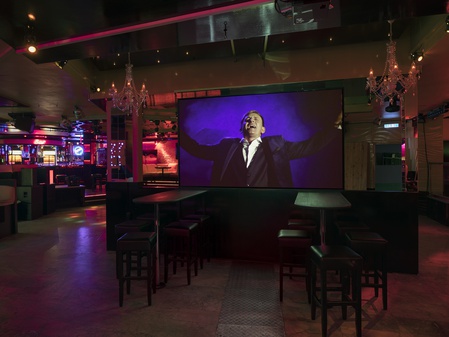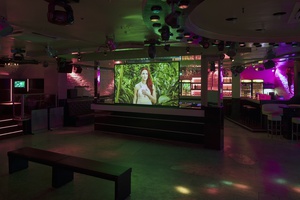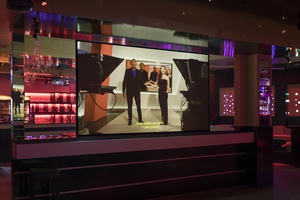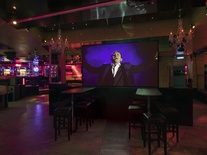Wagner / De Burca (Bárbara Wagner, Benjamin De Burca)
Bye Bye Deutschland! Eine Lebensmelodie [Bye Bye Germany! A Life Melody]
2017
1-channel video projection, 20 min.
Location
Elephant Lounge, Roggenmarkt 15
Temporary installation for the duration of the exhibition
Cast
Mike Förster, Sebastiano Lo Medico, Petra Schwar, Markus Sparfeldt, Makiko Tanaka, Leonardo Teumner, Stefani Teumner
Extras
Ulla Bockhorn, Dorothée Degenhardt, Stephanie Heinrich, Jochen Hohmann, Hannelore Quick
Crew
Directed by: Benjamin de Burca, Bárbara Wagner • Executive producer: Michel Balagué • Production managers: Lejla Aliev, Jan Enste • Postproduction coordinator: Unai Rosende • Research assistant: Hannah Zipfel • Cinematographer: Pedro Sotero • 1st camera assistant: Maíra Iabrudi • 2nd camera assistant, lightning assistant: Jakob Reuter • Gaffer: Gunar Peters • Editor: Eric Ménard • Assistant editor: Mustafa Khalaf • Sound recording, design, and mixing: Gábor Ripli • Music producer: Jochen Hohmann (Starstreet Studio) • Piano: Jürgen Bleibel • Set assistant producer: Sabine Huzikiewiz • Art assistant, make-up, wardrobe: Jana-Kerima Stolzer • Lighting, grip, art assistant: Alexander Rütten • Drone operators: Dirk Lüttke-Harmann, Christopher Müller
Film locations
Botanical Gardens, St Clement Church, Theater Münster, Preussen Stadium, Grille Nightclub and WDR TV Studio Münster
Wagner / De Burca (Bárbara Wagner, Benjamin De Burca)
Bárbara Wagner: * 1980 in Brasília, Brazil, lives in Recife, Brazil
Benjamin de Burca: * 1975 in Munich, Germany, lives in Recife, Brazil
Bárbara Wagner and Benjamin de Burca analyse socio-economic relationships, on the basis, for example, of large urban development projects or specific phenomena from pop culture. After doing investigative research at the site in question, they produce — frequently together with the protagonists of the microcosm they portray — photographic and film formats that capture both documentary and fictional aspects.
For their project in Münster, Wagner and de Búrca have focused on schlager, a particular style of German pop music, and examined the historical and structural principles of this genre by means of music videos produced on location. The Elephant Lounge discotheque in Münster’s historic old town is the starting point for the investigation as well as the venue for the presentation of their video installation. Since 1974, the disco, which is tucked away in a passageway, has been catering to a broad group of people that spans the generations. Following the schlager boom of the 1950s, Germany’s Tin Pan Alley spent decades leading a successful niche existence. After its first renaissance in the 1990s, German pop music is currently experiencing another wave of new, more electronically tinged German-language music whose lyrics and aesthetic tastes are closely associated with the schlager model. Their external perspective enabled the artist duo, who live in Brazil, to view this development and its overall sociocultural context.
Prior to the project in Münster, Wagner and de Búrca took a close look at the brega scene and music industry in the city of Recife in northern Brazil. Tecno brega, which has become very successful in recent years, can be linked musically to the electronic pop culture of the 1980s, although the lyrics describe similarly theatrical visions of love, life, dreams, and sadness, strongly resembling those found in German schlager. Their 2016 film Estas vendo coisas portrays a few of the genre’s singers, dancers, and producers during recording sessions; in formal terms, it makes use of the music video genre, while at the same time deconstructing it.
In a city where cultural perception is often generated and advanced through so-called ‘highbrow’ culture, the post-war music genre of the schlager obviously strikes a certain nerve, which is mirrored in the music’s escapist qualities, catchy motifs, and easily understandable lyrics. The music videos were made on location in Münster and shot with the help of local producers and film crews.
Nico Anklam
Images
Location
- Still existing / Public Collection
- Removed
- In the museum



